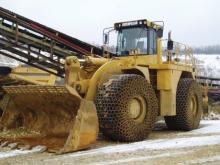Michelin launched the first radial earthmover tyre 50 years ago. Claire Symes takes a look at the development
The shortage of earthmover tyres has been regularly reported in the news recently, but 50 years ago such tyres were hitting the headlines for very different reasons. It was in 1959 that
Michelin's XR concept was tried and tested as it was based on the radial tyres that the company had patented in 1946 and launched for the on-highway market in 1949.
The key development of the radial tyre was the separation of the sidewalls, with a radial architecture, from the tread which gave significant advantages over cross ply tyres. Some of the key benefits included greater resistance to punctures, longer tyre life, improved ride, lower fuel consumption, better traction and increased resistance to heat.
In addition to the different architecture, radial tyres are also manufactured with the piles of cord at 90 degrees to the direction of travel, whereas cross or bias ply tyres used cords applied at 36 to 60 degrees to the direction of travel. The 90 degree angle in the radial tyres prevents the piles rubbing against each other as the tyre flexes which helps reduce the rolling resistance.
In place of the crossed piles in the cross ply, the radial tyre uses steel bands orientated in the direction of travel to add strength, reinforce the tread area and improve service life. But the radial cords in the sidewall give the tyre the necessary flexibility to add ride comfort.
While Michelin was the first company to launch a radial tyre, the invention of the pneumatic tyre is often credited to Scotland's John Boyd
Michelin, which was originally a rubber manufacturing business, moved into the world of tyres as a result of a chance encounter. The company was run by Édouard and André Michelin and after spending three hours helping a cyclist to remove and repair his glued-on pneumatic tyre only for it to fail again after a few hundred metres, the brothers worked on finding a better solution. The company applied for a patent for its removable pneumatic tyre in 1891 which needed no glue to fix it in place.
However, it was the development of the car industry in the early 20th century that really drove expansion of the cross ply tyre industry. Nonetheless, the word tyre - or tire - actually predates the development of pneumatic tyres and comes from the steel bands wheelwrights used to place around wooden wheels to 'tie' the wheel spokes into the wheel.
But it was Michelin's links with the car industry that led to research and development to find an alternative to cross ply tyres. The company, which had bought Citroën in the 1930s, pioneered the X radial tyre in 1946 as part of the development for the front wheeled drive Citroën Traction Avant and Citroën 2CV.
Today, radial tyres are accepted as the industry standard in the construction equipment sector and Michelin manufactures over 93 earthmover radial tyre sizes - ranging from a 424mm diameter up to 4.04m diameter - and over 50 different tread designs.









